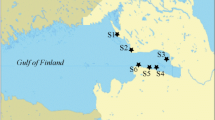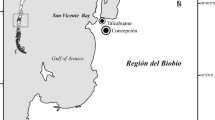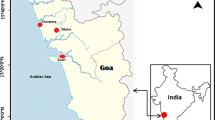Abstract
In the present study, cadmium and lead concentrations were compared in barnacles, ghost shrimps, polychaetes, bivalves, and sediment from ten different locations along the intertidal zone of the Persian Gulf and the Gulf of Oman. The results revealed significant differences in the heavy metal concentrations between the organisms with barnacles showing, by far, the highest metal concentrations. The bioaccumulation factor of Cd in different animals follows this pattern with barnacles > bivalves > polychaetes > ghost shrimps, while the pattern for Pb was barnacles > polychaetes > bivalves > ghost shrimps. In most of the stations, sediments showed the lowest lead and cadmium concentrations. Therefore, it is concluded that barnacles with Pb concentrations between 0.17 and 2,016.1 μg/g and Cd concentrations ranging from 0.4 to 147.1 μg/g are the best organisms to be employed in monitoring programs designed to assess pollution with bioavailable metals in the Persian Gulf and the Gulf of Oman.

Similar content being viewed by others
References
Ali MHH, Fishar MRA (2005) Accumulation of trace metals in some benthic invertebrate and fish species relevant to their concentration in water and sediment of lake Qarun. Egypt. Egypt J Aquat Res 31:289–301
Augustina M, Machiwa JF (2007) Heavy metal pollution levels in water and oysters, Saccostrea cucullata, from Mzinga Creek and Ras Dege mangrove ecosystems, Tanzania. Afr J Aquat Sci 32(3):235–244
Azarbad H, Javanshir Khoi A, Mirvaghefi A, Danekar A, Shapoori M (2010) Biosorption and bioaccumulation of heavy metals by rock oyster. Int Aquat Res 2:61–69
Barbaro A, Francescon A, Polo B, Bilio M (1978) Balanus amphitrite (Cirripedia: Thoracica)—a potential indicator of fluoride, copper, lead, chromium and mercury in North Adriatic Lagoons. Mar Biol 46:247–257
Beeby A (2001) What do sentinels stand for? Environ Pollut 112:285–298
Bettinelli M, Beone GM, Spezia S, Baffib C (2000) Determination of heavy metals in soils and sediments by microwave-assisted digestion and inductively coupled plasma optical emission spectrometry analysis. Anal Chim Acta 424:289–296
Bryan GW, Hummerstone LG (1971) Adaptation of polychaetes Nereis diversicolor to estimate sediments containing high concentrations of heavy metals. 1. General observations and adaptation to copper. J Mar Biol Assoc UK 51:845–863
Bryan GW, Hummerstone LG (1973) Adaptation of the Polychaete Nereis diversicolor to manganese in estuarine sediments. J Mar Biol Assoc UK 53:859–872
Bryan GW, Langston WJ, Hummerstone LG (1980) The use of biological indicators of heavy metal contamination in estuaries. Mar biol Ass UK, Plymouth
Censi P, Spoto SE, Saiano F, Sprovieri M, Mazzola S, Nardone G, Di Geronimo SI, Punturo R, Ottonello D (2006) Heavy metals in coastal water systems. A case study from the northwestern Gulf of Thailand. Chemosphere 64:1167–1176
Einollahi Peer F, Safahieh A, Dadollahi Sohrab A, Pakzad Tochaii S (2010) Heavy metal concentrations in rock oyster Saccostrea cucullata from Iranian costs of the Oman Sea. Trakia J Sci 8:79–86
Eisler R (1985) Cadmium hazards to fish, wildlife, and invertebrates: a synoptic review, 1985, Biological Report (Contaminant Hazards Reviews), 85 (1.2): 46 pages
Eisler R (1988) Lead hazards to fish, wildlife, and invertebrates: a synoptic review. U. S. Fish and Wildlife Service. Biological Report 85 (1.14)
Eriksen KDH, Andersen T, Gray JS, Stenersen J, Andersen RA (1989) Metal - binding in polychaetes: quantitative and qualitative studies of five species. Mar Environ Res 28:167–171
Esen C, Balci A (2008) Application of microwave-assisted digestion to trace heavy metal determination in sea sediment sample. Hacet J Biol Chem 36(2):123–128
Etim L, Akpan ER, Muller P (1991) Temporal trends in heavy metal concentrations in the clam Egeria radiata (Bivalvia: Tellinacea: Donacidae) from the Cross River, Nigeria. Reu Hydrobiol trop 24(4):327–333
Gerhardsson L (2004) Lead. In: Merian E, Anke M, Ihnat M, Stoeppler M (eds) Elements and their compounds in the environment. Wiley, Weinheim, pp 879–900
Griffis RB, Suchanek TH (1991) A model of burrow architecture and trophic modes in thalassinidean shrimp (Decapoda: Thalassinidea). Mar Ecol Prog 79:171–183
Heidarieh M, Ghannadi Maragheh M, Azizi Shamami M, Behgar M, Ziaei F, Akbari Z (2013) Evaluate of heavy metal concentration in shrimp (Penaeus semisulcatus) and crab (Portunus pelagicus) with INAA method. SpringerPlus 2:72
Herber RFM (2004) Cadmium. In: Merian E, Anke M, Ihnat M, Stoeppler M (eds) Elements and their compounds in the environment. Wiley, Weinheim, pp 689–708
Karbassi AR (1998) Geochemistry of Ni, Zn, Cu, Pb, Co, Cd, V, Mn, Fe, Al & Ca in sediments of North Western part of the Persian Gulf. Int J Env Stud 54:205–212
Klerks L, Felder DL, Strasser K, Swarzenski PW (2007) Effects of ghost shrimp on zinc and cadmium in sediments from Tampa Bay, FL. Mar Chem 104:17–26
Nejmeddine A, Dhainaut-Courtois N, Baert JL, Sautière P, Fournet B, Boulenguer P (1988) Purification and characterization of a cadmium-binding protein from Nereis diversicolor (Annelida polychaeta). Comp Biochem Physiol 89C:321–326
Paez-Osuna F, Ruiz-Fernfindez R (1993) Trace metals in the Mexican shrimp Penaeus vannamei from estuarine and marine environments. Environ Poll 87:243–247
Philips DJH, Rainbow PS (1988) Barnacles and mussels as biomonitors of trace elements: a comparative study. Mar Ecol Prog 49:83–93
Pourang N, Dennis JH (2005) Distribution of trace elements in tissues of two shrimp species from the Persian Gulf and roles of metallothionein in their redistribution. Environ Int 31(3):325–341
Rainbow PS (2002) Trace metal concentrations in aquatic invertebrates: why and so what? Environ Poll 120:49507
Rainbow PS (2006) Biomonitoring of trace metals in estuarine and marine environments. Aust J Ecotoxicol 12:107–122
Rainbow PS, Philips DJH (1993) Cosmopolitan biomonitors of trace metals. Mar Poll Bull 26:593–601
Rainbow PS, Scott AG (1979) Two heavy metal binding proteins in the midgut gland of the crab Carcinus maenas. Mar Biol 55:143–150
Rainbow PS, Smith BD (1992) Biomonitoring of Hong Kong coastal trace metals by barnacles, 1986–1989. In: Morton B (ed) The marine flora and fauna of Hong Kong and Southern China III. Proceedings of the fourth international marine biological workshop: the marine flora and fauna of Hong Kong and Southern China, Hong Kong. Hong Kong University Press, Hong Kong, pp 585–597
Raissy M, Ansari M, Rahimi E (2011) Mercury, arsenic, cadmium and lead in lobster (Panulirus homarus) from the Persian Gulf. Tocicol Ind Health 27(7):655–659
Reis PA, Salgado MA, Vasconcelos V (2011) Barnacles as biomonitors of metal contamination in coastal waters. Estuar Coast Shelf Sci 93(4):269–278
Reish DJ, Gerlinger TV (1997) A review of the toxicological studies with polychaetous annelids. B Mar Sci 60:584–607
Saiz-Salinas JI, Frances-Zubillaga G (1997) Nereis diversicolor: an unreliable biomonitor of metal contamination in the Ría de Bilbao (Spain). Mar Ecol 18:113–125
Shahdadi A (2007) Taxonomy and biogeography of intertidal barnacles (Crustacea, Cirripedia) of the Persian Gulf and the Gulf of Oman. Unpublished M.Sc. thesis, University of Tehran
Shahdadi A, Sari A (2011) Chthamalid barnacles (Cirripedia: Thoracica) of the Persian Gulf and Gulf of Oman, Iran. J Mar Biol Assoc UK 91(3):745–753
Silva CAR, Smith BD, Rainbow PS (2006) Comparative biomonitors of coastal trace metal contamination in tropical South America (N. Brazil). Mar Environ Res 61:439–455
Singer C, Zimmermann S, Sures B (2005) Induction of heat shock proteins (hsp70) in the zebra mussel (Dreissena polymorpha) following exposure to platinum group metals (platinum, palladium and rhodium): comparison with lead and cadmium exposures. Aqua Toxicol 75:65–75
Sures B (2004) Environmental parasitology: relevancy of parasites in monitoring environmental pollution. Trends Parasitol 20:170–177
Sures B, Siddall R (1999) Pomphorhynchus laevis: the intestinal acanthocephalan as a lead sink for its fish host, chub (Leuciscus cephalus). Exp Parasitol 93:66–72
Walker G, Rainbow PS, Foster P, Crisp DJ (1975) Barnacles: possible indicators of zinc pollution? Mar Biol 30:57–65
White SL, Rainbow PS (1984) Zinc flux in Palaemon elegans (Crustacea: Decapoda): moulting, individual variation and tissue distribution. Mar Ecol Prog 19:153–166
Zorita I, Zarragoitia M, Soto M, Gajaraville P (2006) Biomarkers in mussels from a copper site gradient (Visnes, Norway) an integrated biochemical, histochemical and histological study. Aqua Toxicol 78:109–116
Acknowledgments
The authors would like to thank the Department of Environment of Iran and the University of Tehran for financial support and Mr. Abbas Kazemi for his help during the specimen collections.
Author information
Authors and Affiliations
Corresponding author
Additional information
Responsible editor: Philippe Garrigues
Rights and permissions
About this article
Cite this article
Amoozadeh, E., Malek, M., Rashidinejad, R. et al. Marine organisms as heavy metal bioindicators in the Persian Gulf and the Gulf of Oman. Environ Sci Pollut Res 21, 2386–2395 (2014). https://doi.org/10.1007/s11356-013-1890-8
Received:
Accepted:
Published:
Issue Date:
DOI: https://doi.org/10.1007/s11356-013-1890-8




